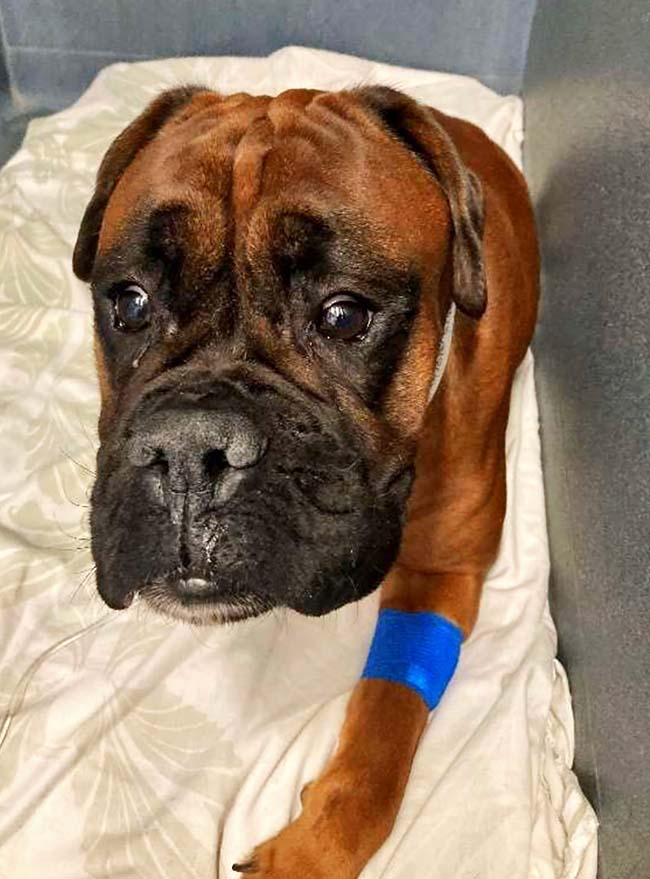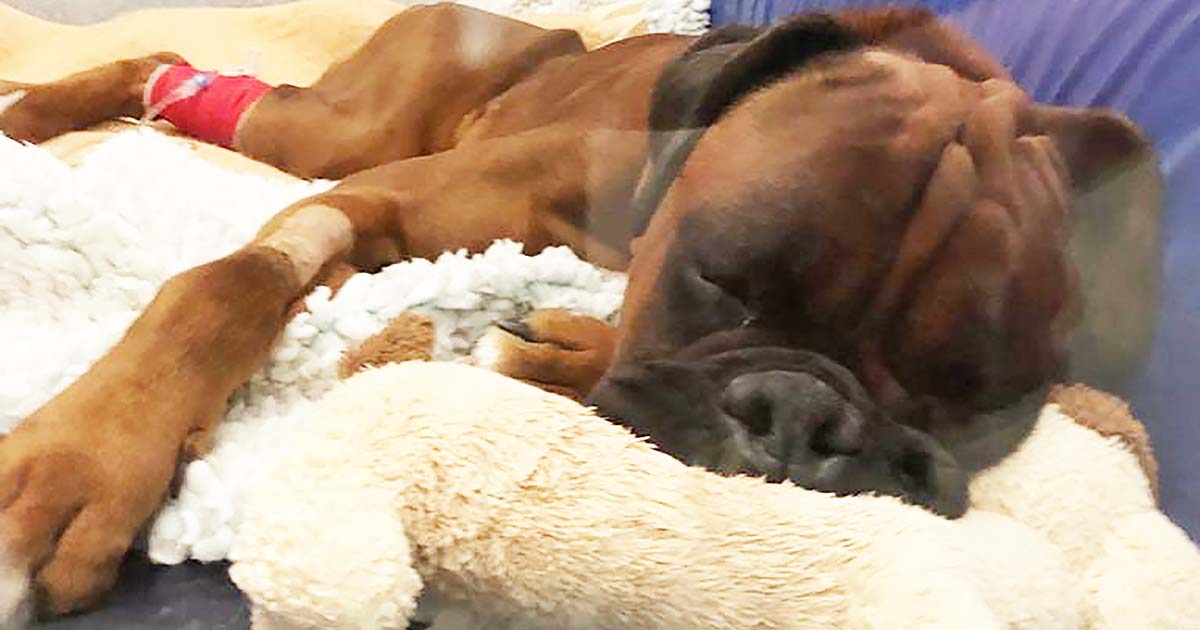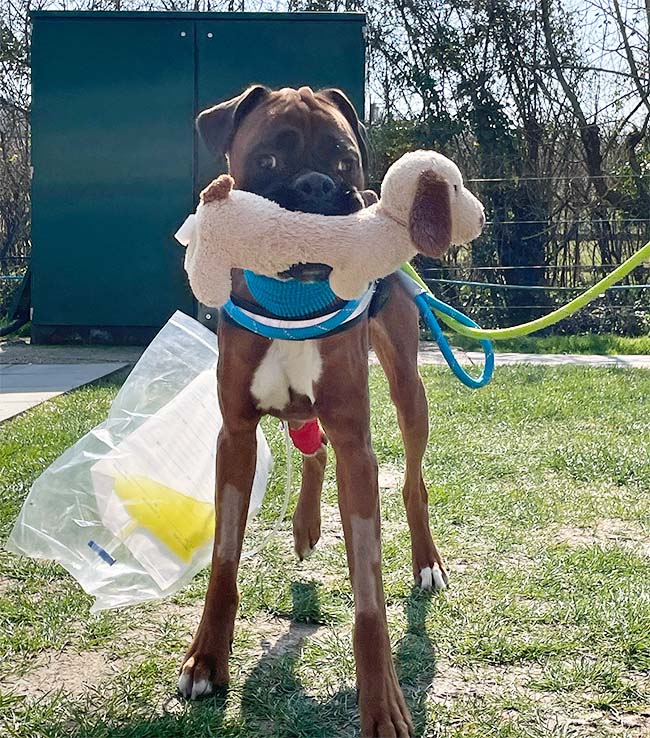14 Jun 2022
Leila Hallaji shares a case of a young boxer diagnosed with this potentially life-threatening infection, detailing the treatment and care it received.

Otis resting. His reduced body condition can be seen clearly – especially around his hips.
Otis – a one-and-a-half-year-old, male entire boxer – was presented to Anderson Moores Veterinary Specialists in March 2022 for emergency investigation of diarrhoea and neurological signs.
Over three to four days Otis had developed vomiting and diarrhoea, and, while he had been interested in eating, his owners reported that he was dropping food from his mouth and seemed unable to swallow normally.
He deteriorated rapidly, over 24 hours, developing lethargy and anorexia, and on presentation he appeared vacant and uninterested in his surroundings. When lifted, his body and limbs seemed rigid. A mild stertor was noted, as well as reluctance to open his mouth.
Otis was referred to the internal medicine department, where his physical examination showed he had a slightly reduced body condition. He was quiet, alert and responsive, but reluctant to stand and walk. He had marked tightening of his facial muscles, consistent with Risus sardonicus. His vital parameters were normal.

Over digit IV on his right pelvic limb mild swelling was present and a small, healing wound, which did not seem painful on palpation.
Otis was also examined by the neurology department, which revealed a stiff gait and slightly increased postural tone.
Otis’ facial expression and neurological abnormalities, paired with the recent wound to the digit, were highly suggestive of tetanus infection.

Tetanus is caused by neurotoxins released by the bacteria Clostridium tetani1. This bacterium originates from the soil and can enter the body via open wounds or penetrating injuries. Diagnosis is generally based on a consistent physical examination and history.
Clinical signs can take up to three weeks to become apparent; however, most cases show symptoms within 5 to 12 days after injury2.
Tetanus can be graded in its severity into four classes, with a worse prognosis associated with higher classes. Otis presented with class II disease:
The prognosis for dogs that remain ambulatory is excellent, but is more guarded for dogs that become recumbent, and cases can take one to two weeks to reach maximum severity. Aspiration pneumonia is a significant cause of morbidity and mortality3.
It was recommended that Otis was admitted to start immediate treatment and further monitoring.
Supportive care was initiated, which included fluid therapy, assisted feeding and antibiotic therapy. While antibiotics have no effect on the toxin, they are used to eliminate C tetani and stop further toxin production1,4.
Co-amoxiclav and metronidazole were used. Metronidazole tends to be the antibiotic of choice based on studies in human medicine1.
As Otis presented in the early stages of the disease, it was felt that he could benefit from tetanus antitoxin. The antitoxin works by binding to circulating toxins and preventing them from attaching to the nerve cells4.
The efficacy of this treatment is uncertain, with no studies having proven a definite benefit1,2. However, the team wished to halt progression to the generalised form if at all possible. Administration can cause adverse effects, such as vomiting, tachycardia and tachypnoea; therefore, Otis needed close monitoring for these signs, and chlorphenamine and adrenaline were available in case of anaphylaxis.
Although Otis’ gag reflex was present, he appeared unable to swallow food. Therefore, a nasogastric feeding tube was placed initially to facilitate continued nutrition.
The muscle contractions and rigidity associated with tetanus are likely to be painful; therefore, the anaesthesia department provided a multimodal analgesic plan consisting of opioids in combination with ketamine and paracetamol. NSAIDs tend to be avoided due to the increased risk of gastric ulceration in these patients1. Diazepam was used for both muscle relaxation and as an anxiolytic.
Due to the risk of potential urinary retention, an indwelling urinary catheter was placed. This also allowed his urine output to be monitored, and minimised the stimulation of manual expression or needing to urinate when unable to stand.
Sadly, Otis’ tetany signs progressed further; he became recumbent, began to regurgitate, and developed recurrent upper respiratory tract obstruction due to an accumulation of saliva/mucus and, most likely, laryngospasm. To manage these complications, a temporary tracheostomy tube was placed by the soft tissue surgery department, as well as an oesophageal feeding tube.
Otis required intensive care and hospitalisation in the high-dependency unit. Tetanus can cause hypersensitivity to noise, light and touch; therefore, he required a dark, quiet environment with minimal stimulation. Cotton wool was placed in his ears to reduce noise sensitivity and his treatments were coordinated at set times to allow minimal handling.
Due to his recumbency and rigidity, Otis required turning every three to four hours. Prolonged periods of being in lateral recumbency can cause pressure on the lungs. This pressure decreases the amount the lung can inflate, and, therefore, can lead to atelectasis5.
Another potential complication for recumbent patients is the development of decubital ulcers; therefore, padding was provided around any bony prominences and between his limbs. He was provided with soft, comfortable bedding and an orthopaedic mattress. It was important that his tracheostomy tube was not occluded when laying down; therefore, his head and neck were supported and extended.
The tracheostomy tube required nebulising and suctioning every two to four hours to prevent secretions from drying up and blocking the tube. Otis was monitored for noisy breathing indicating secretion build-up, increased airway resistance or obstruction. The tracheostomy tube needed replacing every 24 hours.
Otis’ respiratory rate and effort were monitored closely, along with his oxygen saturation via pulse oximetry and temperature. Hyperthermia can be a potential complication due to the muscle contractions1. It was essential that Otis remained calm and cool while it was in situ.
Otis’ urinary catheter required cleaning and his bladder emptying every four hours. His urine output was monitored closely to ensure he was adequately hydrated. His fluids were adjusted based on his hydration status, which was monitored by checking his bodyweight, his urine output, and regular blood sampling looking at serum biochemistry and PCV/total solids.
Otis was a high risk for hospital-acquired infection due to the number of indwelling devices he had in situ and his being immunocompromised. Therefore, all indwelling devices were handled aseptically to reduce this risk. However, he did develop a urinary tract infection (UTI), which was diagnosed from a sterile urine sample and treated with appropriate antibiotics (marbofloxacin) based on the culture and sensitivity test results.
Otis required oral and ocular care due to his inability to lubricate these areas. This was to prevent oral and corneal ulcers from developing.
The nursing team administered his medications, monitored his vital parameters and provided assisted feeding via his oesophageal tube. He tolerated his tube feeding well; however, he continued to lose weight, which was addressed by increasing his caloric intake. He was fed a blended gastrointestinal diet to reduce the risk of digestive upset and help with digestion. He continued to be tube fed for three weeks for fear of inducing aspiration if fed by mouth. Even though he was very keen to eat by this point, it was in his best interest to continue assisted feeding.
For a brief period, Otis was showing possible seizure activity (associated with a very guarded prognosis), and was treated with levetiracetam. However, this was considered most likely to have been rapid eye movement sleep behaviour disorder rather than true seizure episodes, which has been associated with tetanus6. When no further seizure activity occurred, the levetiracetam was successfully discontinued.
Otis’ mobility started to improve and after two weeks of hospitalisation, he was able to maintain a sitting position and stand unassisted, and his ambulation was improving. It was joyous to see him walk and even try to run. He was able to yawn and was keen to play with toys provided.
The physiotherapy department introduced passive range of movement exercises to help minimise joint stiffness, reduce discomfort associated with muscle rigidity and prevent muscle wastage.
The tracheostomy tube was removed after 12 days. Several attempts to remove his urinary catheter were made; however, he was still having difficulty urinating and fully voiding his bladder.
After 22 days, the urinary catheter was finally removed and Otis was able to produce small amounts of urine. The nurses were ecstatic when he first urinated by himself. He still required manual bladder expression to help him fully void and needed medication to help urethral sphincter relaxation (prazosin). Otis remained in hospital until his urination improved and he was able to be fed by mouth without any complications.
After four weeks, Otis was allowed to be fed by mouth. He ate keenly and showed no signs of dysphagia or regurgitation. He loved to play with toys and enjoyed his walks outside.
Although he was principally managed by the internal medicine department, significant input occurred from the emergency and critical care, soft tissue surgery, neurology and anaesthesia departments. However, the greatest contributor to his recovery was considered to be the intensive nursing he received day and night.
After four weeks of hospitalisation and capturing everyone’s hearts, Otis was finally discharged in April 2022 and is doing well at home.

Tetanus can be a debilitating disease that requires critical care and intensive nursing. Potential exists for a good prognosis; however, owners need to be made aware of the potential serious complications, such as aspiration pneumonia and UTI, as well as the prolonged hospitalisation, which can carry significant financial implications1. For this reason, many patients are euthanised.
Although nursing these patients is intense, if the owners are able to continue treatment and the patient responds then they are extremely rewarding.